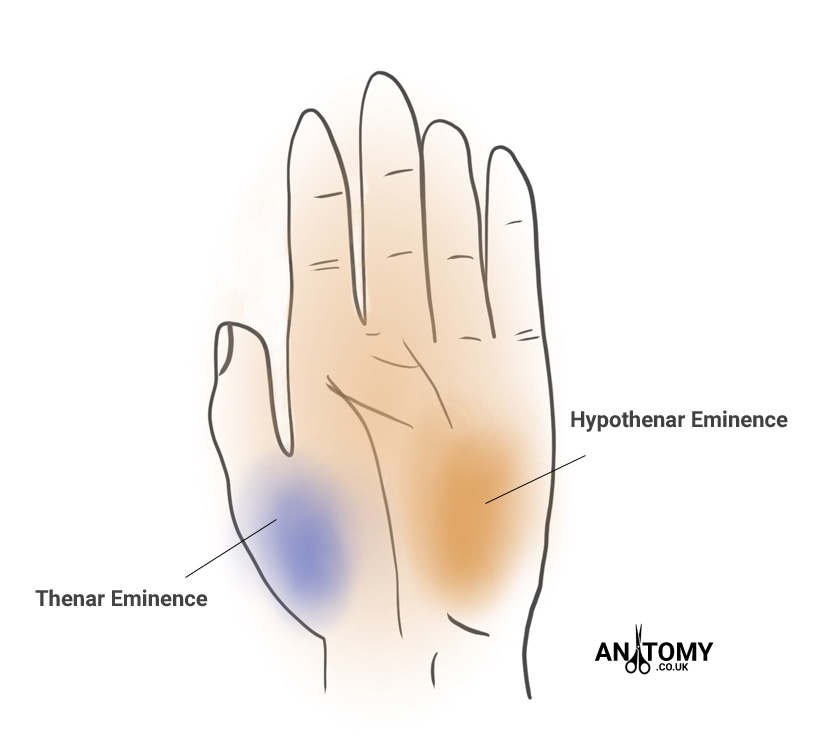TE
Thenar Eminence
Thumb muscle group enabling fine movements
RegionUpper Limb
SystemMusculoskeletal System
What is Thenar Eminence?
Thenar Eminence refers to a group of three short muscles located at the base of the thumb. This group of muscles forms a “fleshy mass” on the lateral side of the palm which is responsible for the thumb’s fine movements.[2]Anatomy
The following three muscles are referred to as a group as the thenar eminence. Picture 1: Muscles involved in thenar eminence
Picture 1: Muscles involved in thenar eminence
1. Opponens Pollicis
This small, triangular muscle lies deep in the hand, under the other two muscles. Its function is to oppose the thumb by medially rotating and flexing the metacarpal on the trapezium.[4] This allows the thumb to touch the other fingers of the hand, and apply grip movements.2. Abductor Pollicis Brevis
This flat, thin muscle lies just under the skin, and is the most superficial of the thenar eminence muscles. As its name suggests, it functions as an abductor of the thumb, or moves the thumb away from the hand.3. Flexor Pollicis Brevis
This muscle has both a superficial part, and a deep part. The job of this muscle is to flex the thumb, or bend it.[1] All three muscles are innervated by the recurrent branch of the median nerve. This is a branch of the median nerve which supplies the thenar muscles. A fourth muscle, called the adductor pollicis is also responsible for fine movements of the thumb, but is not part of the thenar group. This muscle controls rotation and opposition of the thumb, or moving the thumb toward the hand. It is supplied by the ulnar nerve.Hypothenar Muscles
 Picture 2: Hypothenar muscles
Picture 2: Hypothenar muscles
Causes of Thenar Eminence Pain
Repetitive Movements
Because the thumb is the most mobile of all the fingers, it is susceptible to repetitive movements and overuse. The thenar muscles allow the thumb to move in all different directions, making the thumb essential in many daily activities.[5] Some people experience thenar eminence pain because of guitar playing, some people experience it because of gardening. Writing, typing, knitting, using tools, and using a smartphone are just some of the activities that require repetitive functions of the thenar group which tire the muscles out.Injury
Other causes of discomfort in the thenar muscular group can include injury or pain after a fall or an accident. If this group of muscles is crushed, it can result in a wide spectrum of injuries, from contusion, or bruising, to total loss.[6] This raises concern for the functioning of the thumb. One danger of injury to the muscles is compartment syndrome, when excessive pressure builds up in the enclosed muscle space. This syndrome can result from bleeding or swelling, and if not treated immediately may result in permanent damage to the muscles.Carpal Tunnel Syndrome
Carpal tunnel syndrome is a condition in which there is pressure on the median nerve in the wrist. The median nerve travels through a small place called the carpal tunnel. When that space is compromised due to swelling, a person will experience soreness, numbness, tingling, weakness, and other symptoms. If a person is experiencing discomfort in the thumb, index finger, middle finger, and the thumb side of the ring finger for an extended period of time, it is likely that he/she is suffering from carpal tunnel syndrome. A different nerve supplies the muscles of the little finger; therefore, a person with carpal tunnel syndrome will not be affected in the little finger.Who is at risk for developing carpal tunnel syndrome?
Those that work in a profession requiring repetitive or forceful hand movements, working in awkward positions, or working with vibrations. These professions can include: massage therapists, factory workers, hairdressers, bakers, gardeners, musicians, cashiers, and many others. Those suffering from illnesses that cause swelling in the joints and soft tissues. These conditions include: diabetes, gout, hypothyroidism, lupus, obesity, and rheumatoid arthritis. People with broken wrist bones, dislocated bones, new bone growth from healing, or bone spurs.Thenar Muscle Atrophy
In advanced carpal tunnel syndrome, the patient may suffer from thenar muscle atrophy due to loss of nerve supply and disuse. The median nerve is the sole nerve supply of the thenar muscles. This nerve supplies finger sensation and muscle function to the thumb, index finger, middle finger, and half of the ring finger. When the muscles start atrophying, the sensory fibers have already been damaged for an extended period of time. Thenar muscle fasciculations, or involuntary and visible twitches in the thenar muscle group, may be a sign of atrophy. Fasciculations are produced because of the denervation of the muscle. Once fasciculations are present, atrophy usually comes two to three weeks later. Muscle atrophy causes permanent weakness and loss of function. Often, before carpal tunnel advances to this stage, surgery will be suggested to create space for the median nerve, and allow it to supply the thenar muscles.Treatment of Thenar Eminence Pain
Before pain gets so bad that surgery is required, there are quite a few treatments to consider helping reduce swelling and inflammation in the thenar muscles.- Splinting the thumb to reduce movement
- Non-steroidal anti-inflammatory drugs (NSAIDs)
- Steroid injections
- Palpitation of the neck and adjustments by a physiotherapist or orthopedic surgeon
Alternative Therapies
- Cold compression for 10 minutes at a time a few times a day to reduce swelling
- Acupressure or acupuncture
- Deep tissue massage to relax tight muscles
- Regular stretching
- Myofascial release or Trigger point therapy
Published on May 20, 2017
Last updated on April 24, 2025
Last updated on April 24, 2025